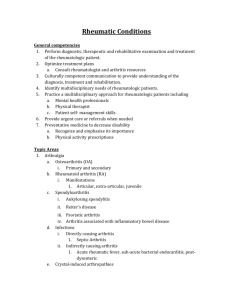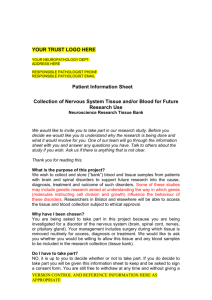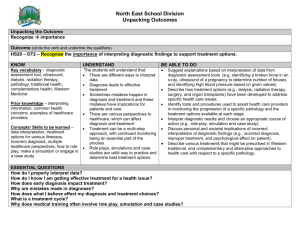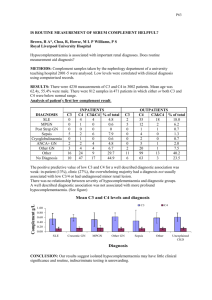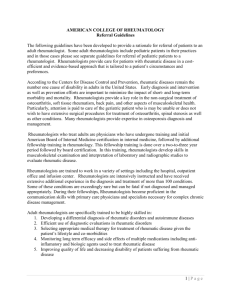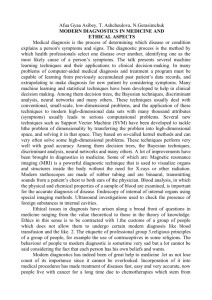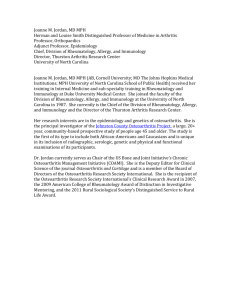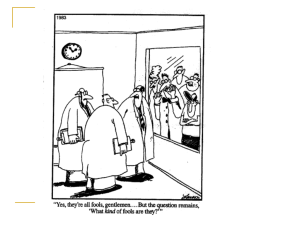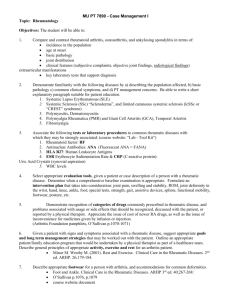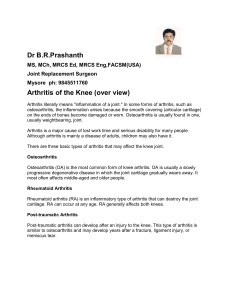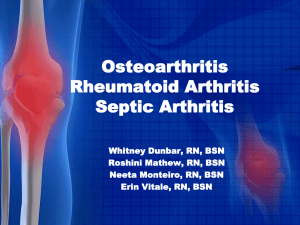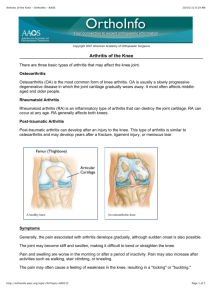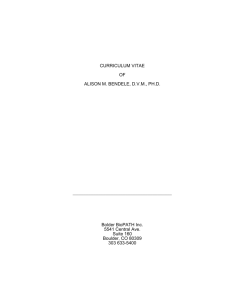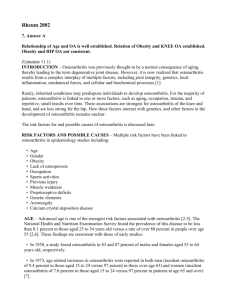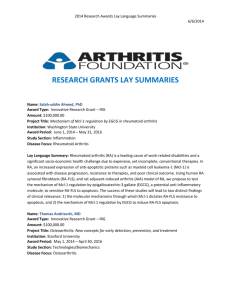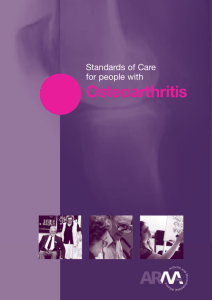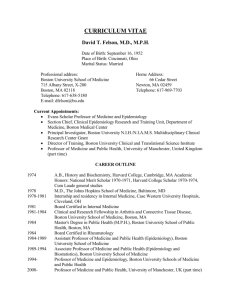Tbilisi State University, Faculty of Medicine Course: Case Based
advertisement
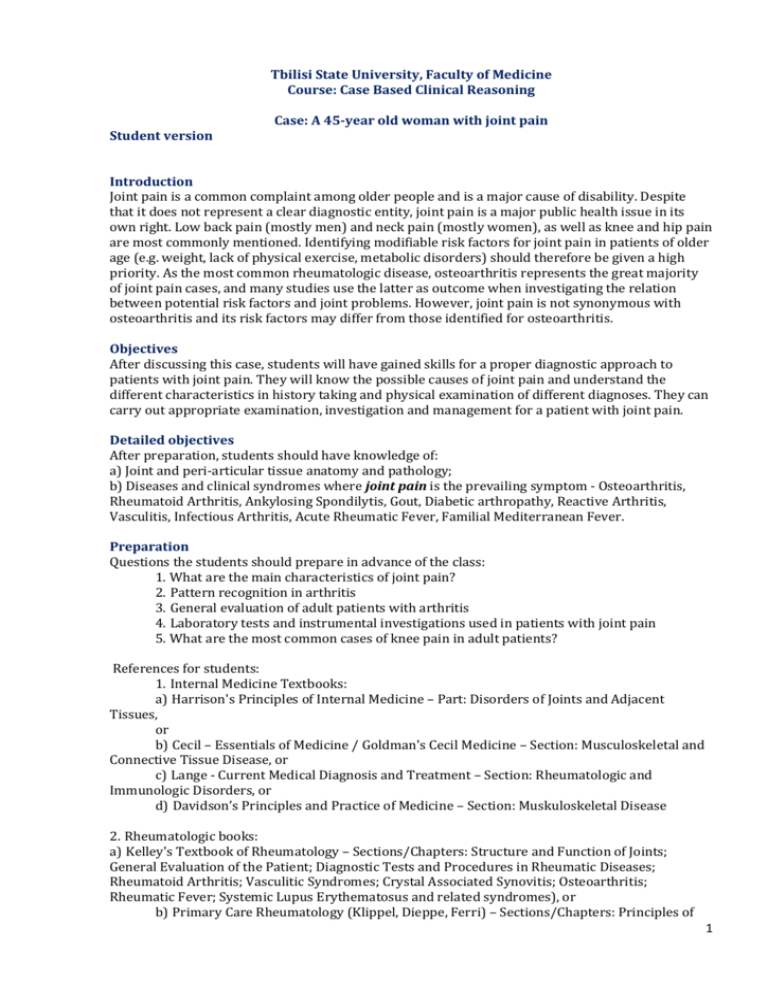
Tbilisi State University, Faculty of Medicine Course: Case Based Clinical Reasoning Student version Case: A 45-year old woman with joint pain Introduction Joint pain is a common complaint among older people and is a major cause of disability. Despite that it does not represent a clear diagnostic entity, joint pain is a major public health issue in its own right. Low back pain (mostly men) and neck pain (mostly women), as well as knee and hip pain are most commonly mentioned. Identifying modifiable risk factors for joint pain in patients of older age (e.g. weight, lack of physical exercise, metabolic disorders) should therefore be given a high priority. As the most common rheumatologic disease, osteoarthritis represents the great majority of joint pain cases, and many studies use the latter as outcome when investigating the relation between potential risk factors and joint problems. However, joint pain is not synonymous with osteoarthritis and its risk factors may differ from those identified for osteoarthritis. Objectives After discussing this case, students will have gained skills for a proper diagnostic approach to patients with joint pain. They will know the possible causes of joint pain and understand the different characteristics in history taking and physical examination of different diagnoses. They can carry out appropriate examination, investigation and management for a patient with joint pain. Detailed objectives After preparation, students should have knowledge of: a) Joint and peri-articular tissue anatomy and pathology; b) Diseases and clinical syndromes where joint pain is the prevailing symptom - Osteoarthritis, Rheumatoid Arthritis, Ankylosing Spondilytis, Gout, Diabetic arthropathy, Reactive Arthritis, Vasculitis, Infectious Arthritis, Acute Rheumatic Fever, Familial Mediterranean Fever. Preparation Questions the students should prepare in advance of the class: 1. What are the main characteristics of joint pain? 2. Pattern recognition in arthritis 3. General evaluation of adult patients with arthritis 4. Laboratory tests and instrumental investigations used in patients with joint pain 5. What are the most common cases of knee pain in adult patients? References for students: 1. Internal Medicine Textbooks: a) Harrison's Principles of Internal Medicine – Part: Disorders of Joints and Adjacent Tissues, or b) Cecil – Essentials of Medicine / Goldman's Cecil Medicine – Section: Musculoskeletal and Connective Tissue Disease, or c) Lange - Current Medical Diagnosis and Treatment – Section: Rheumatologic and Immunologic Disorders, or d) Davidson’s Principles and Practice of Medicine – Section: Muskuloskeletal Disease 2. Rheumatologic books: a) Kelley's Textbook of Rheumatology – Sections/Chapters: Structure and Function of Joints; General Evaluation of the Patient; Diagnostic Tests and Procedures in Rheumatic Diseases; Rheumatoid Arthritis; Vasculitic Syndromes; Crystal Associated Synovitis; Osteoarthritis; Rheumatic Fever; Systemic Lupus Erythematosus and related syndromes), or b) Primary Care Rheumatology (Klippel, Dieppe, Ferri) – Sections/Chapters: Principles of 1 Diagnosis and Management; Regional Pain and Monoarticular Disorders; Polyarticular Disorders; Systemic Lupus Erythematosus; Acute Rheumatic Fever; Older People 3. Websites: a) http://www.nmihi.com/i/arthralgia.htm References for Peer Teachers (in addition to the above mentioned) 1. http://www.medscape.com/viewarticle/705219 2. http://www.medscape.com/viewarticle/774928 Suggested non-medical reading: Jorge Luis Borges – “The Garden of Forking Paths” ("El Jardín de senderos que se bifurcan") Assessment Students: 0 points absence or presence without relevant participation 1 point normal active participation Peer teachers: 0 points poor preparation, insufficient leadership of the session 1 point sufficient preparation, moderate leadership of the session 2 points good preparation, good leadership of the session Estimated time schedule Case 2 hrs (with 15 min break) Lecture - 7 min Q.1 – 7 min Q. 2 – 7 min Q. 3 – 7 min Q.4 – 15 min Q.5 – 10 min Q.6 – 15 min Q.7 – 10 min Q.8 – 10 min Q.9 – 10 min Q.10 – 10 min Q.11 – 5 min Q.12 – 7 min Stage I - Presentation of patient's problem Case You are a GP. At your office, a 45-year old woman, former kindergarten teacher and now agent of a beauty products selling company, presents with complaints of prolonged, mild to moderate pain in her left knee for the last three months. Sometimes the pain is present in the left ankle too, often coinciding with exacerbation of knee pain. You haven’t seen the patient before, as she recently moved to your district. Question 1. What is the main problem of this patient? Question 2. What is the most likely cause of the joint pain for this patient? Group your hypothesis in three categories (I -Likely, II-Less Likely, III – Not very Likely, but 2 not excluded) Question 3. Which questions must be asked to discriminate between the most relevant hypotheses? Stage II - Results of history taking Hand-out 1 (shown on the screen and read out loud) Question 4 . What is the most likely diagnosis now? Question 5. Which parts of physical examination are required in order to exclude some unlikely, but important hypotheses? Which physical examinations are necessary to confirm the most likely hypothesis and discriminate between others? Question 6. Is there any diseases in the table you would now exclude from the list? Or maybe the information provided makes you thinking to add some new diagnosis to the table? Question 7. Which hypotheses now remain in the differential diagnosis to be further investigated? Question 8. Which diagnostic investigations need to be done, to confirm or exclude the remaining diagnoses? Stage IV - Results of diagnostic investigations Hand-out 3 (shown on the screen and read out loud) Question 9. Interpret the findings from the diagnostic tests. How much certainty do they give about the hypotheses? Question 10. Which diagnosis prevails now? Question 11. Given this diagnosis and patient circumstances, which therapy or policy for care is now indicated? What is the prognosis if the patient is treated? What if the patient would not be treated? Stage V – Results of therapeutic management Hand-out 4 (shown on the screen and read out loud) Question 12. One of the students from the group summarizes the whole case chronologically in a few minutes. 3 4


